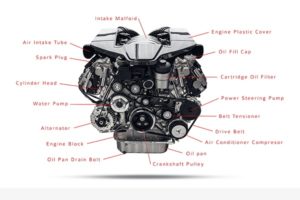
Despite their relatively easy operation, cars are actually very complex machines. Cars need fuel to operate, but what does the engine actually do with it?
In general, a standard internal combustion engine — what the majority of fuel-powered vehicles have today — uses air combined with gasoline to produce power.[1] Of course, it gets more complicated.
Components of an engine
Before diving into how a car engine functions, it will help to learn its basic anatomy (also critical if you need to perform any car maintenance). Take a look at the car engine diagram below, then review the list of the engine’s main components and their function:

- Engine block: Typically made of iron or aluminum, the engine block houses the majority of the parts that make the engine run, including the cylinders, pistons, crankshaft and camshaft.[2] (If you’re popping open the hood, the engine block will usually have the alternator mounted to the front of it.)
- Cylinder head: The cylinder head encompasses the components that manage the flow of intake air and exhaust gases, such as the valves and camshafts.[2]
- Crankshaft: The crankshaft transforms the up-and-down motion of the pistons into a corresponding circular motion. It’s attached to the pistons through a connecting rod.[2]
- Connecting rods: The connecting rod affixes the crankshaft to the pistons. It rotates at each end, giving it the flexibility to move with both components.[3]
- Pistons: Pistons move up and down within the cylinder, delivering energy to the crankshaft, which in turn powers the vehicle for motion. Piston rings located inside the pistons help seal the edges of the cylinder and reduce friction while they’re in motion.[2],[3]
- Spark plugs: Spark plugs cause combustion to occur by creating a spark that ignites the incoming mixture of air and fuel.[3]
- Fuel injectors: The fuel injector supplies the engine with fuel. In the process, it turns the fuel into tiny, mist-like particles so that it can be more easily burned by the engine.[4]
- Valves: There are two types of valves in the engine: intake valves and exhaust valves. The former lets air and gas into the engine; the latter releases exhaust.[3]
- Camshaft: The camshaft oversees the opening and closing of the valves. To do this, it converts the circular motion of the crankshaft into an up-and-down motion that opens and shuts the valves.[2]
- Timing belt or chain: The timing belt or chain runs between the camshaft and the crankshaft to make sure they’re working in sync.[2]
The four-stroke cycle engine process
Most internal combustion engines operate in a four-step cycle process. These steps are formally known as strokes, in reference to the four movements a piston makes to complete each cycle. The strokes occur in this order: intake, compression, combustion, exhaust.
At each stroke, the piston is either on its way up or down within the cylinder, moving in conjunction with the intake of air and fuel or the expulsion of exhaust. Here’s an overview of how the process works[1]:
1. Intake stroke
During the intake stroke, the piston shifts downward while the intake valve opens to let in a stream of gasoline and air. Once the piston reaches the base of the cylinder, the valves close, sealing the gasoline-and-air mixture in. (It’s worth noting that in some modern vehicles, gasoline is injected later during the compression stroke.)
2. Compression stroke
At this point, the piston moves back upward to compress the gas and air toward the top of the cylinder. Pushing this mixture into a more confined space prepares it to be ignited in the combustion stroke.
3. Combustion stroke
Also known as the power stroke, the combustion stroke is what truly creates your engine’s power and gets the car moving. Here, the spark plug fires to ignite the gas. The resulting heat and expanding gas force the piston back down the cylinder.
4. Exhaust stroke
When the piston reaches the bottom of the cylinder, the exhaust valve opens so the piston can pump the spent gases out of the engine. From there, the gases go into the exhaust system and exit the vehicle. Finally, the exhaust valve closes and the four-stroke cycle repeats.
Different types of car engines
While all internal combustion engines generally work the same, there are several different types of engines. When discussing engines that most commonly appear in personal vehicles, the differences mainly have to do with how the cylinders are arranged. For instance, the cylinders of inline engines are lined up straight, while in V-style engines, the cylinders are separated into two groupings and form a V shape. Other engines will adjust certain mechanics — such as the valve timing or the amount of air added to the four-stroke cycle — to create more efficiency or power.[1]
Knowing how a car engine works may prove helpful when it’s time to buy your next car, especially if you’re getting it used from an individual instead of from a dealership. Learn how to buy a car from a private seller.
[1] “This Is How Your Car’s Engine Works,”(April 17, 2019)
[2] “Car Engine Parts,”(accessed Sept. 24, 2020)
[3] “How Car Engines Work,”(accessed Sept. 24, 2020)
[4] “How Fuel Injection Systems Work,” (accessed Sept. 24, 2020)



